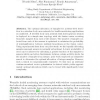Free Online Productivity Tools
i2Speak
i2Symbol
i2OCR
iTex2Img
iWeb2Print
iWeb2Shot
i2Type
iPdf2Split
iPdf2Merge
i2Bopomofo
i2Arabic
i2Style
i2Image
i2PDF
iLatex2Rtf
Sci2ools
DCOSS
2009
Springer
2009
Springer
Optimal Allocation of Time-Resources for Multihypothesis Activity-Level Detection
Abstract. The optimal allocation of samples for activity-level detection in a wireless body area network for health-monitoring applications is considered. A wireless body area network with heterogeneous sensors is deployed in a simple star topology with the fusion center receiving biometric samples from each of the sensors. The number of samples collected from each of the sensors is optimized to minimize the probability of misclassification between multiple hypotheses at the fusion center. Using experimental data from our pilot study, we find equally allocating samples amongst sensors is normally suboptimal. A lower probability of error can be achieved by allocating a greater fraction of the samples to sensors which can better discriminate between certain activity-levels. As the number of samples is an integer, prior work employed an exhaustive search to determine the optimal allocation of integer samples. However, such a search is computationally expensive. To this end, an alternate...
Body Area Network | DCOSS 2009 | Distributed And Parallel Computing | Optimal Allocations | Wireless Body Area |
| Added | 26 May 2010 |
| Updated | 26 May 2010 |
| Type | Conference |
| Year | 2009 |
| Where | DCOSS |
| Authors | Gautam Thatte, Viktor Rozgic, Ming Li, Sabyasachi Ghosh, Urbashi Mitra, Shrikanth Narayanan, Murali Annavaram, Donna Spruijt-Metz |
Comments (0)

